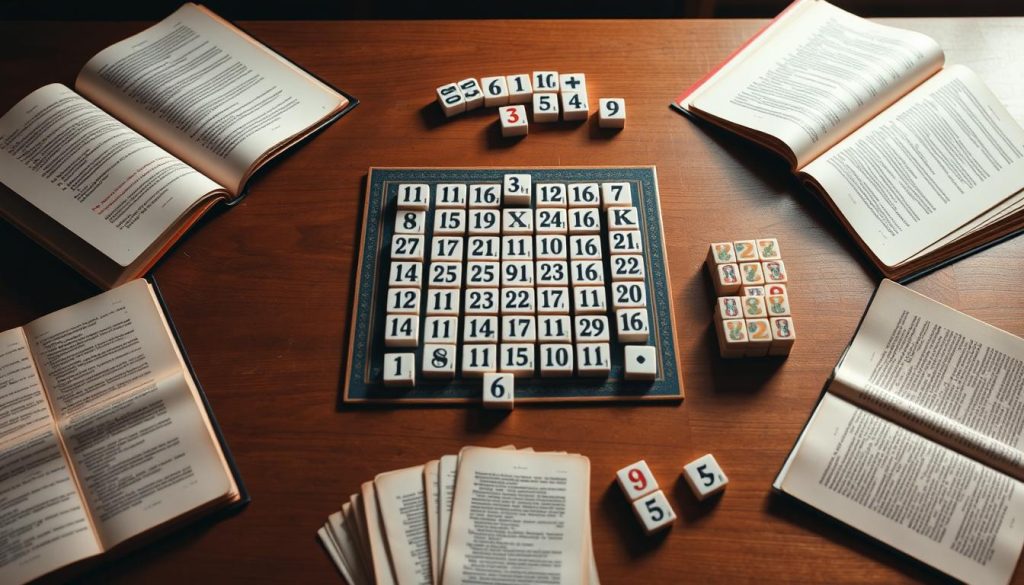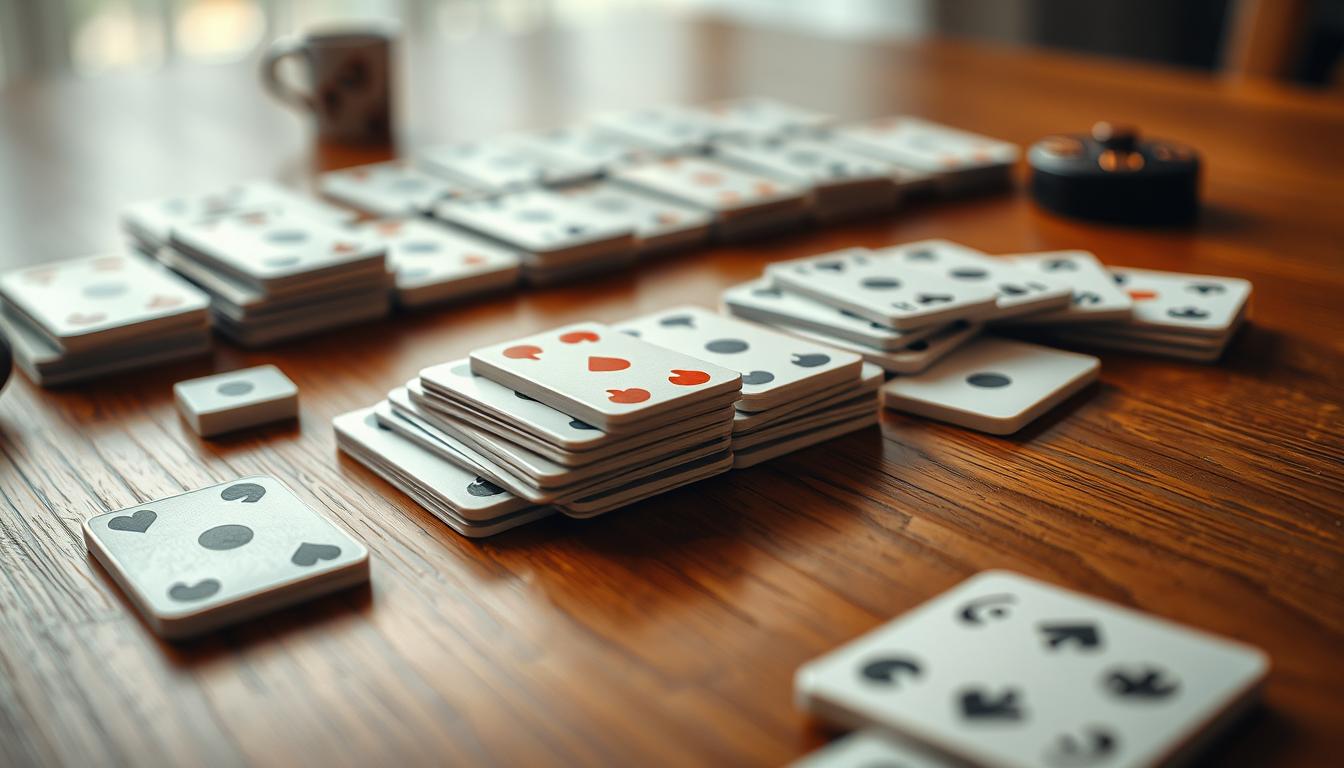Rummy is a fun card game loved by many in the United States. It’s great for playing with friends or learning new card game basics. Rummy is both exciting and strategic, appealing to all skill levels.
This guide will teach you the key rummy rules. You’ll go from being a beginner to a skilled player. You’ll learn about card combinations and strategies to start your rummy adventure.
Learning rummy is more than just following rules. It’s about quick thinking, planning, and enjoying time with friends. Our guide will make learning easy and fun, helping you get into the game smoothly.
Are you ready to explore the world of rummy? It’s where skill, luck, and strategy meet. By the end of this guide, you’ll know how to play well and impress your friends.
Understanding the Basics of Rummy Card Game
Rummy is a fun card game that needs strategy and a little luck. It’s a popular game that’s easy to learn. This guide will help you get started with rummy.
The game is about making certain card combinations and lowering your score. You need to know how to make sets and sequences to win.
Card Values and Scoring System
In rummy, the value of each card matters a lot. Here’s how cards are scored:
- Face cards (Jack, Queen, King): 10 points each
- Ace: 1 or 10 points (depending on the variation)
- Number cards: Face value (2 of hearts = 2 points)
- Joker: 0 points
Different Types of Rummy Games
There are many fun rummy games to try:
- Gin Rummy: A two-player game with special rules
- Indian Rummy: A 13-card game for 2-6 players
- Contract Rummy: A game with changing goals
- Canasta Rummy: A complex game using many decks
Essential Rummy Terminology
Learn these key rummy terms to improve your game:
- Meld: A valid combination of cards
- Run: Consecutive cards of the same suit
- Set: Three or four cards of the same rank
- Discard: Placing an unwanted card face-up
Knowing these basics will help you enjoy rummy more.
Setting Up Your Rummy Game

To start a rummy game, you need to follow a few steps. First, gather the right materials. Then, create a welcoming game space for everyone.
You’ll need a full deck of 52 playing cards for a standard rummy game. It’s great for 2-6 players, making it perfect for small groups. The way you deal the cards is key to getting the game ready.
- Choose a clean, well-lit table with enough space for all players
- Shuffle the deck thoroughly to ensure random card distribution
- Determine the number of cards to deal based on the specific rummy variant
How you deal the cards depends on the rummy game you’re playing. In most games, each player gets 13 cards. The rest of the cards form the draw pile, with the top card turned face-up to start the discard pile.
- Select a dealer (can be done by drawing the highest card)
- Distribute cards clockwise to each player
- Place the remaining cards face down as the draw pile
- Turn the top card of the draw pile face up to begin the discard pile
Keeping your cards organized is crucial. Use a card holder or arrange them neatly. This helps you plan your moves and makes the game fun for everyone.
How to Play Rummy: Rules and Gameplay
Rummy is all about smart card moves and planning. You need to learn how to make winning hands. Knowing the basics is key to playing well.
The game focuses on making sets and sequences. You start with a set number of cards. Then, you draw and discard to improve your hand.
Drawing and Discarding Cards
- Start by drawing a card from the deck or discard pile
- Think about how the card can help you
- Discard a card that doesn’t fit your plan
- Try to get rid of cards that help your opponents
Forming Sets and Sequences
Creating sets and sequences is crucial:
- Pure Sequences: Three or more cards in a row of the same suit
- Sets: Three or four cards of the same rank but different suits
Declaring and Winning
To win, you need to declare with the right sets and sequences. You must have at least two sequences, one being pure. Watching your opponents and discarding wisely is important.
With practice and patience, you’ll get better at rummy. You’ll understand card combinations and strategies better.
Essential Strategies for Beginners

Mastering rummy tactics is more than just playing cards. Beginners can boost their game by learning key card management and smart strategies.
First, learn to evaluate your hand well. Success in rummy comes from quick, smart choices about which cards to keep or discard. Beginners should focus on these main strategies:
- Prioritize creating pure sequences first
- Watch your opponents’ discard patterns
- Keep flexible cards that can work in multiple combinations
- Minimize high-value card risks
Card management is key to rummy success. Always keep a balanced hand with many options for sets and sequences. Try to hold cards that can form different combinations, making you more flexible during the game.
Understanding risk is also vital. Learn to figure out the chance of getting needed cards and when to take risks. New players should practice reading the game and making strategic moves to win.
- Observe opponent’s picked and discarded cards
- Track potential card combinations
- Know when to drop from a game
Practice is the best way to get better at rummy. Every game is a chance to improve your strategies and understand the game better.
Common Mistakes to Avoid in Rummy
Mastering rummy is more than just knowing the rules. Experienced players know that avoiding common mistakes can greatly improve your game. New players often make strategic errors that cost them points and potential wins.
Understanding rummy means spotting and fixing beginner errors. It’s key for improving your game and playing smarter.
Card Management Errors
Good card management is crucial in rummy. Players often make mistakes that hurt their chances of winning:
- Holding onto high-value cards for too long
- Failing to track discarded cards
- Ignoring potential card combinations
- Not prioritizing sequence formation
Strategic Blunders
Good strategy is what sets novices apart from experts. Common mistakes include:
- Focusing too narrowly on a single meld
- Neglecting to observe opponents’ card selections
- Rushing declarations without proper sequence completion
- Overlooking potential defensive plays
Timing Mistakes
Timing is everything in rummy. Mistakes to avoid include declaring too early, missing chances to win, and not adjusting your strategy as the game goes on.
By understanding and fixing these mistakes, players can improve their game, make fewer errors, and win more often.
Advanced Rummy Techniques and Tips

To get better at rummy, you need more than basic rules. Advanced strategies make you stand out. Professional players use special techniques to play better.
Improving at rummy means using smart strategies. You need to read your opponents, know card chances, and make smart choices.
- Master card counting techniques
- Learn strategic discard methods
- Practice psychological gameplay
- Understand probability calculations
Watching cards is key to being good. By tracking what’s thrown away, you can guess what others have. Good players know how cards might fit together.
Bluffing is a clever trick in rummy. By choosing cards carefully, you can trick others about what you have. This takes practice and paying close attention.
- Watch opponent discard patterns
- Create misleading card sequences
- Minimize predictable gameplay
- Adapt quickly to changing game dynamics
Getting better at rummy takes time and thinking ahead. Every game is a chance to learn and get better.
Understanding Card Combinations and Melds
Rummy is a card game that focuses on making strategic combinations. It’s key to know how to make different sequences and sets to win. This skill is crucial for success.
In rummy, players try to sort their cards into groups with special rules. These groups are called melds. There are three main types:
- Pure Sequences
- Impure Sequences
- Sets and Trios
Pure Sequences
A pure sequence is a group of three or more cards in the same suit. They must be in order and without wild cards. For example, 5♥, 6♥, 7♥ is a valid sequence.
Impure Sequences
Impure sequences are like pure sequences but allow wild cards. A joker can replace a missing card to make a valid sequence.
Sets and Trios
Sets are groups of three or four cards with the same rank but different suits. A trio has three cards with the same value. Knowing these techniques helps you win at rummy.
Practicing these combinations will boost your rummy skills. It will also up your chances of winning.
Mastering the Art of Observation
Rummy psychology is more than just playing cards. It’s about understanding the game’s deep dynamics. Players with sharp eyes spot subtle cues that show what their opponents might do next.
Getting good at observing takes time and effort. To improve your rummy skills, focus on these key areas:
- Track discarded cards carefully
- Notice patterns in opponents’ card selections
- Read non-verbal communication signals
- Analyze opponents’ reaction times
Good game analysis is more than just watching cards. It’s about reading body language, timing discards, and guessing strategies. Knowing how to read the table can make you win more games.
Some important techniques for observing include:
- Watching card exchanges closely
- Identifying hesitation in opponent’s moves
- Recognizing bluffing patterns
- Understanding emotional responses
Top rummy players spend a lot of time studying how others play. By using these techniques, you’ll get better at understanding the game’s psychological side.
Online Rummy: Digital Version Basics
Digital card games have changed how we play online rummy. Now, players can connect and compete from anywhere. These platforms make rummy fun and easy to play online.
Players can enjoy many benefits:
- 24/7 availability of game rooms
- Instant matchmaking with global players
- Multiple game variations
- Secure digital payment systems
- Practice modes for skill development
Choosing the right platform is important. Top sites have easy-to-use interfaces and strong security. New players should look at reviews and game options.
Safety is key in online gaming. Here are some tips:
- Verify platform legitimacy
- Use strong account passwords
- Understand platform’s privacy policies
- Monitor personal gaming expenditures
- Recognize potential addiction risks
Modern platforms use advanced tech for fair play. Players can join tournaments and practice with a few clicks.
Tournament Rules and Competitive Play
Rummy tournaments add excitement for card game fans. They test skills and strategy. Whether you play for fun or to win, knowing the rules helps improve your game.
Players need to know the different formats of rummy tournaments. These formats make the games exciting and challenging. There are many ways for skilled players to show off their skills.
Tournament Formats Explained
- Knockout Tournaments: Single elimination style where losing players are immediately removed
- Round-Robin Competitions: Each player competes against every other participant
- Point-Based Tournaments: Winners determined by cumulative points across multiple rounds
Point Systems in Competitive Rummy
Scoring in rummy tournaments has its own rules. Points are given for good card combinations and successful plays. Knowing how points work is key to winning.
Prize Structures
- Cash Prizes for Top Performers
- Tiered Reward Levels
- Tournament-Specific Bonus Rewards
Top rummy players spend a lot of time practicing. They learn to analyze opponents and play consistently. Success comes from always learning and adapting.
Building Your Personal Playing Style
Creating your own rummy techniques is key to getting better. Everyone has their own way of playing. Your style will grow as you play more and learn from each game.
First, figure out what you’re good at and what you need to work on in rummy. Watch how skilled players make their moves. See how they manage their cards and guess what others might do next.
Playing a lot helps you improve your strategy. Every game is a chance to try new things. Learn from your wins and losses. Remember, getting better is a journey.
There’s no one right way to play rummy. The best players change their strategy based on the game and who they’re playing. Be true to your style but always be ready to learn and grow.

